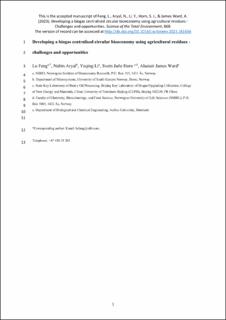| dc.contributor.author | Feng, Lu | |
| dc.contributor.author | Aryal, Nabin | |
| dc.contributor.author | Li, Yeqing | |
| dc.contributor.author | Horn, Svein Jarle | |
| dc.contributor.author | James Ward, Alastair | |
| dc.date.accessioned | 2023-07-17T10:09:51Z | |
| dc.date.available | 2023-07-17T10:09:51Z | |
| dc.date.created | 2023-01-17T11:58:00Z | |
| dc.date.issued | 2023 | |
| dc.identifier.issn | 0048-9697 | |
| dc.identifier.uri | https://hdl.handle.net/11250/3079596 | |
| dc.description.abstract | Anaerobic digestion (AD) can be used as a stand-alone process or integrated as part of a larger biorefining process to produce biofuels, biochemicals and fertiliser, and has the potential to play a central role in the emerging circular bioeconomy (CBE). Agricultural residues, such as animal slurry, straw, and grass silage, represent an important resource and have a huge potential to boost biogas and methane yields. Under the CBE concept, there is a need to assess the long-term impact and investigate the potential accumulation of specific unwanted substances. Thus, a comprehensive literature review to summarise the benefits and environmental impacts of using agricultural residues for AD is needed. This review analyses the benefits and potential adverse effects related to developing biogas-centred CBE. The identified potential risks/challenges for developing biogas CBE include GHG emission, nutrient management, pollutants, etc. In general, the environmental risks are highly dependent on the input feedstocks and resulting digestate. Integrated treatment processes should be developed as these could both minimise risks and improve the economic perspective. | |
| dc.language.iso | eng | |
| dc.title | Developing a biogas centralised circular bioeconomy using agricultural residues - Challenges and opportunities | |
| dc.title.alternative | Developing a biogas centralised circular bioeconomy using agricultural residues - Challenges and opportunities | |
| dc.type | Peer reviewed | |
| dc.type | Journal article | |
| dc.description.version | acceptedVersion | |
| dc.source.volume | 868 | |
| dc.source.journal | Science of the Total Environment | |
| dc.identifier.doi | 10.1016/j.scitotenv.2023.161656 | |
| dc.identifier.cristin | 2108464 | |
| dc.relation.project | Norges forskningsråd: 319723 | |
| dc.relation.project | Norges forskningsråd: 257622 | |
| cristin.ispublished | true | |
| cristin.fulltext | postprint | |
| cristin.qualitycode | 2 | |
